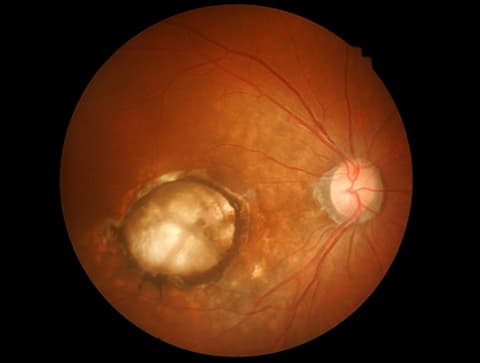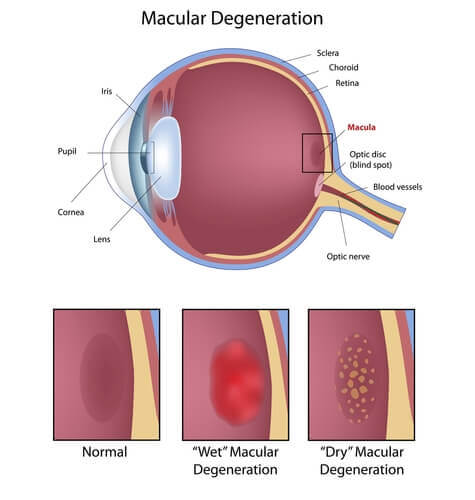Macular Degeneration

Macular degeneration, often called AMD or ARMD (for age-related macular degeneration), is the leading cause of vision loss and blindness in Americans aged 65 and older.
Because older people represent an increasingly larger percentage of the general population, vision loss associated with AMD is a growing problem.
Significant vision loss accompanying more advanced forms of AMD increases from fewer than 1% among individuals in their 60s to more than 15% among people in their 90s. Almost two million U.S. residents now have significant symptoms associated with age-related macular degeneration, with that number expected to grow to almost 3 million by 2020.
AMD is a degenerative condition of the macula, which is the part of the retina responsible for the sharp, central vision needed to read or drive. Because AMD affects the macula, central vision loss may occur.
Macular degeneration is diagnosed as either dry (non-neovascular) or wet (neovascular). The dry form is more common than the wet, with about 85%-90% of AMD patients diagnosed with dry AMD. The wet form of the disease usually leads to more serious vision loss.
Macular Degeneration Symptoms and Signs
Macular degeneration usually produces a slow, or rarely, sudden painless loss of vision. Early signs of vision loss associated with AMD can include seeing shadowy areas in your central vision or experiencing unusually fuzzy or distorted vision.
Viewing a chart of black lines arranged in a graph pattern (Amsler grid) is one way to tell if you are having these vision problems.
When macular degeneration is suspected, a brief test using an Amsler Grid that measures your central vision may be performed. Additional tests are sometimes needed to specifically examine the retinal blood vessels surrounding the macula.
What Causes Macular Degeneration?
Aside from possible links to a gene deficiency, the exact causes of age-related macular degeneration are still unknown. The dry form of AMD may result from the aging and thinning of macular tissues, depositing of pigment in the macula, or a combination of the two processes. With wet AMD, new blood vessels grow (neovascularization) beneath the retina and leak blood and fluid. This leakage causes retinal cells to die and creates blind spots in central vision.

Other risk factors for AMD include having a family member with AMD, smoking, high blood pressure, lighter eye color, farsightedness, and obesity. Some researchers believe that over-exposure to sunlight also may be a contributing factor in the development of AMD, but this theory has not been proven conclusively. High levels of dietary fat also may be a risk factor for developing AMD.
Treatment of Macular Degeneration

There is as yet no outright cure for macular degeneration, but some treatments may delay its progression or even improve vision.
Visudyne drug treatment (Photodynamic Therapy or PDT). Visudyne was the first drug therapy for the treatment of the wet form of the disease. It is only for those patients who have new blood vessel growth (neovascularization) under the retina in a well defined, distinctive pattern.
In this Macular Degeneration treatment procedure, the doctor injects Visudyne into your arm, then activates the drug as it passes through the retinal blood vessels by shining a non-thermal laser into your eye.
Visudyne activation produces a chemical reaction that destroys abnormal blood vessels. About 15% of Visudyne treated patients achieve improved vision, and it may help to slow the progression of Macular Degeneration in treated patients.
Other light-activated drugs that operate in ways similar to Visudyne also are under investigation.
Anti-Angiogenic drug treatments (Macugen, Avastin, Lucentis). This new treatment uses therapeutic molecules to attack a protein that causes abnormal blood vessel growth in the eye; the first (Macugen) was FDA-approved in December 2004.
The medications are administered through injections into the eye. In clinical trials, some macular degeneration patients experienced slower rates of vision loss, and some even had restored vision.
Vitamins and minerals. Research suggests that antioxidant vitamins, such as beta-carotene (vitamin A) and vitamins C and E, may protect the macula from damage.
The AREDS study involving more than 3,600 people found that supplementation with vitamins C and E, beta-carotene and zinc reduced certain patients’ risk of progressing to advanced AMD by about 28%. This number reflects those patients with large numbers of intermediate or large yellowish deposits (drusen) on their retinas, but not those with limited intermediate drusen or multiple small drusen.
Because of their findings, the researchers recommend that patients at risk of developing advanced AMD consider taking antioxidant and zinc supplements. Participants received:
- 500 milligrams (mg) of vitamin C
- 400 international units (IU) of vitamin E
- 15 mg of beta-carotene
- and 80 mg of zinc oxide
The eye care community does not agree on the benefits of zinc or antioxidant supplements: more study is needed, especially on the long-term effects of high-dose supplementation.
Other Treatments in Development
Various other drugs and treatment modalities are under investigation. One interesting approach is an Implantable telescope which can magnify images onto the retina to improve central vision damaged by the progression of AMD.
Magnification of the overall image reduces the impact of the central blind spot. Other research endeavors have been aimed at developing artificial retinas or methods of stimulating the retina for those who have experienced permanent vision loss from retinal disease.
Low vision devices for vision loss. Although much progress has been made recently in macular degeneration treatment research, any central vision lost to dry AMD will probably not be restored. It is important to check your vision regularly with an Amsler grid.
Viewing the Amsler grid separately with each eye helps you monitor your vision loss. The Amsler grid is a very sensitive test that typically reveals clinical findings before the doctor can actually see physical findings.
For those who have suffered vision loss, many low vision devices are available to help improve vision by using magnifying lenses and bright lights. Some low vision aids actually shift images to the periphery for clearer vision.



